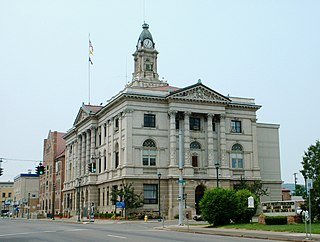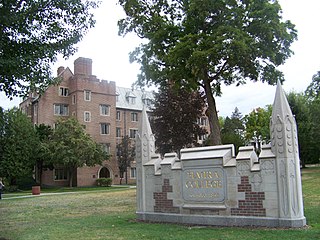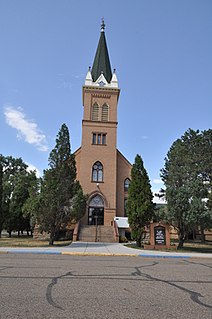
Elmira is a city and the county seat of Chemung County, New York, United States. It is the principal city of the Elmira, New York, metropolitan statistical area, which encompasses Chemung County. The population was 26,523 at the 2020 census, down from 29,200 at the 2010 census, a decline of more than 7 percent.
The Salem United Church of Christ, known in previous generations as the Salem German Evangelical Reformed Church or Deutsche Evangelisch Reformierte Salems Kirche, is located at 1425 Sycamore Street in the Over-the-Rhine neighborhood of Cincinnati, Ohio. The church holds membership in the United Church of Christ, the successor to the German Reformed tradition.
Henry C. Dudley (1813–1894), known also as Henry Dudley, was an English-born North American architect, known for his Gothic Revival churches. He was a founding member of the American Institute of Architects and designed a large number of churches, among them Saint Paul's Episcopal Cathedral in Syracuse, New York, built in 1884, and Trinity Church, completed in 1858.

Emmanuel Episcopal Church is located at 380 Pennsylvania Avenue in Elmira, New York. It is significant for its High Victorian Gothic style of architecture. The surface of the cast concrete building was cast to resemble rough cut stone. This church was added to the National Register of Historic Places in November, 1998.

The Elmira College Old Campus is the historic part of Elmira College in Elmira, New York. Historically known as The Elmira Collegiate Seminary or The Elmira Female College, the college was the first in the United States to offer to women a degree program on a par with programs offered to men. The contributing structures are significant examples of the architecture of the period. The contributing buildings are Cowles Hall, Hamilton House, Mark Twain's Study, Gillett Hall, Carnegie Science Hall, Fassett Commons, Tompkins Hall, and Hamilton Hall.

Park Church runs the length of an entire city block in Elmira, New York. The church was constructed from 1874 through 1876, replacing its much smaller, wooden predecessor. It was designed by Horatio Nelson White. The design of the limestone and brick church is highly eclectic. Besides its architecture, the church is significant for its congregation of abolitionists and humanitarians. From 1854 until his death in 1900, Thomas Kennicott Beecher was the pastor of Park Church. Beecher, together with his twelve siblings including author Harriet Beecher Stowe, was brought up by liberal reformist clergyman Lyman Beecher.

Zion-St. Mark's Evangelical Lutheran Church, formerly known as Deutsche Evangelische Kirche von Yorkville and Zion Lutheran Church, is a historic Lutheran church at 339-341 East 84th Street in Yorkville, Manhattan, New York City. The congregation is a member of the Evangelical Lutheran Church in America.

Pentecostal Holy Temple Church of Jesus Christ, formerly known as The Free Baptist Church, was a historic Baptist church located at Elmira in Chemung County, New York. It was built in 1882 and is an example of late 19th century Gothic Revival style ecclesiastical architecture. The building has been demolished.
First Congregational Church and Society of Volney, also known as Bristol Hill Church, Congregational United Church of Christ, is a historic Congregational church located at Volney in Oswego County, New York. It is a frame vernacular Federal style structure built in 1832–1835. It is a two-story structure, rectangular in plan, 40 feet wide and 54 feet deep. A tower extends from the center of its facade. Except for the loss of its bell, the church is in virtually original condition. Early members of the church were abolitionists and the church is known to have had African American members dating to the 1820s.

First Lutheran in Houston is a historic Lutheran church at 1311 Holman Street in Houston, Texas. It is part of the North American Lutheran Church (NALC). The current church building was constructed in 1927 in a Lombard Romanesque style. The church building was added to the National Register of Historic Places in 2006.
Christ Church, more commonly known as the Unitarian Universalist Fellowship or First Universalist Church of Middletown is a historic Universalist church located at Middletown in Orange County, New York. It was built in 1901. It features an offset bell tower and Tiffany glass memorial window. Also located on the property is an earlier frame parish house.

St. Paul's United Church of Christ of Laramie was founded in 1886 as the first German language congregation in Wyoming. The church building was listed on the National Register of Historic Places in 1983. The cornerstone was laid on July 13, 1890, three days after statehood. Clergy from Chicago and the local Christian, Methodist, Episcopal, Presbyterian and Baptist Churches participated in the ceremony, with an address by Dr. John Wesley Hoyt, former Governor of Wyoming Territory and at the time first president of the University of Wyoming. The building was completed and dedicated on January 18, 1891. It is the oldest church structure in Laramie continuously used by the same congregation. With its stained glass windows and heavy wooden furnishings, St. Paul's is reminiscent of rural German churches. Those elaborate windows and its many simplified Gothic elements make the building unique among Lutheran churches in Wyoming.

The German Evangelical St. Johns Church on Church Avenue in Hebron, North Dakota, also known as the Deutsche Evangelische St. Johannes Kirche, is now known as St. John United Church of Christ. The church building was listed on the National Register of Historic Places in 2001.

First German Reformed Church was a historic church built in 1891 at 413 Wisconsin Avenue in Waukesha, Wisconsin, United States. It was added to the National Register of Historic Places in 1991. The 1891 building burned to the ground in 2005.

Evangelische Lutherische Emanuels Kirche, also known as Emmanuel Evangelical Lutheran Church and Hill Church, is a historic Lutheran church complex and national historic district located near Dubois in Harbison Township, Dubois County, Indiana. The main church was built in 1901, and is a one-story, rectangular High Victorian Gothic style frame building. It has a front gable roof and rests on a stone foundation. It features a large steeple structure consisting of a square tower, octagonal drum, and spire. Also on the property are the contributing cemetery, schoolhouse (1889), and parsonage (1891).

The Deutsche Evangelische Christuskirche is a church on Montpelier Place in Knightsbridge, London. German Christian theologian Julius Rieger has described it as the most significant German church in London.

Deutsch Evangelische St. Paul's Kirche is a historic Evangelical Protestant church located at Santa Claus, Spencer County, Indiana. It was built in 1880, and is a one-story, wood-frame building sheathed in clapboard siding. It sits on a sandstone block foundation and has a gable roof. It features a square bell tower with steeple measuring 70 feet tall. The building was moved to Santa Claus Park in 2012.

Jefferson Historic District is a national historic district located at Lafayette, Tippecanoe County, Indiana. The district encompasses 161 contributing buildings, 2 contributing sites, and 22 contributing structures in a predominantly residential section of Lafayette. It developed between about 1853 and 1951 and includes representative examples of Italianate, Greek Revival, and Bungalow / American Craftsman style architecture. Notable contributing resources include the Deutsche Evangelische Kirche (1905), Isador Metzger House, Hubert Gilmartin House, B.F. Biggs Pump Factory Building, Deutsche Methodist Kirche (1885), Herman & Mary Fletemeyer House, Mohr House, Warrenberg-Reule Double House, Alfred Gaddis House, Wabash Valley House (1862), Haywood Tag Company Building (1928), and Jefferson High School (1927).

Evangelische Lutherische Dreienigkeit Kirche, also known as the Trinity Evangelical Lutheran Church Complex, is a historic church building in Grand Island, Nebraska. It was built in 1894-1896 by two German immigrants, Jacob and William Scheffel. Others on the building committee were E. Wiederaenders, F. Pribnow, J. Ruff, J. Schinkel and F. Eggers.. The congregation served pioneers from Germany. The building was designed in the Romanesque Revival architectural style. It has been listed on the National Register of Historic Places since December 1, 1986.

The Deutsche Evangelisch Lutherische Zion Kirche, also known as Our Redeemer Lutheran Church of Marysville, is a historic church building in Staplehurst, Nebraska. It was built in 1917 "as the culmination of the fund-raising efforts of farmers in rural Seward County." It was designed in the Late Gothic Revival style by George A. Berlinghof and Ellery L. Davis. It has been listed on the National Register of Historic Places since June 25, 1982.






















